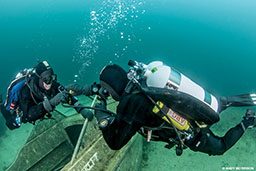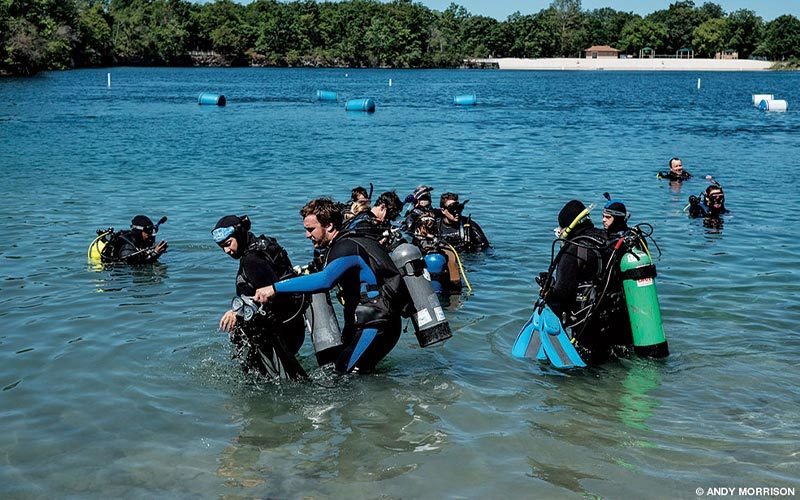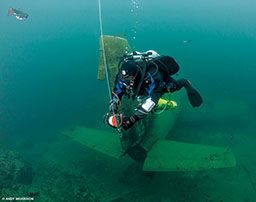We were gearing up on a sunny spring day at our local dive quarry. I had not dived for some months, and I recalled last year’s DAN Annual Diving Report, in which we had written a section about diving fatalities in quarries, lakes and dive parks. There are more than 150 such sites — also known as scuba parks — in the U.S. and Canada, most of them near large population centers.

In our review we looked at the past 10 years and found 47 deaths in dive parks (defined as any freshwater site that deliberately placed attractions to entice divers) and 63 diving deaths at other freshwater sites such as rivers and lakes. (We excluded caves because cave diving is highly specialized.) We compared these two groups to identify safety issues we might warn the diving community about.
Although we didn’t know where all the divers got their gear, we did know that information in 47 cases. Of these, 36 percent were wearing rented or borrowed equipment. The percentage was the same for freshwater diving fatalities both inside and outside of dive parks, but it was a much higher rate than for diving deaths in the sea, where we found that just 26 percent of divers who died were wearing unfamiliar gear.
Fatalities in dive parks peaked in May, earlier in the year than those in other freshwater sites or in the sea. I wondered if this timing might be a result of many divers returning to diving after the winter with a day at their local quarry. Maximum depths where divers died were significantly deeper in dive parks (76 feet compared with 39 feet outside of dive parks), and technical diving was also more common in dive parks than at other freshwater sites (17 percent versus 6 percent), probably due to greater access to deeper depths. Training was the purpose of the dive in 28 of the 110 freshwater deaths (25 percent).

The top three causes of death were drowning, cardiac problems and arterial gas embolism (AGE), as is commonly found in the sea. One thing that stood out, though, was that all five AGE events occurred in dive parks.
It was important to DAN researchers to figure out how to use these data to assist the diving community, so our next step was to look at our database of diver-supplied reports to help us better understand the causes of injuries and incidents. This incident report from a dive park contains some common elements:
I accompanied a class of students on a dive in a quarry. We visited a helicopter in water deeper than 60 feet. Once the class had performed their exercises, my buddy led the way from the helicopter to an underwater boat. The instructor and students followed at a distance. When we arrived at the boat, which was at about 45 feet, we stopped and turned around.
Unknown to us, about 10 yards away a diver in the class began to experience difficulty breathing through his regulator, and he quickly became low on air. He looked at his pressure gauge and saw that the pressure dropped to zero with each difficult breath. I did not see him since he was coming down at an angle and I was facing away from him. My buddy handed the diver a spare air supply twice, and he let go of it. He looked panicked.
Fortunately, staying calm saved the day in this case, and both divers surfaced unharmed. However, this incident should remind us all to regularly check our gas supply, especially when we dive deeper than usual. This incident also includes common elements of incidents such as a diver in training, diving more deeply than usual and being at risk of a panicked ascent, which is a well-established factor in many AGE deaths.
Summary
On average, 11 divers die each year in fresh water in the U.S. and Canada. Almost half of these deaths occur in dive parks, which are typically deeper than other freshwater dive sites. Technical diving was more common in dive-park deaths than in deaths outside of dive parks.

Training was the purpose of the dive in 25 percent of the fatalities. Unfamiliar gear is a hazard for all divers; it may be more common at freshwater sites where training is popular. DAN recommends that divers take a few minutes before diving to become familiar with any new, borrowed or rented equipment. Check it carefully before entering the water, and when possible try it in water shallow enough to stand up in before going deeper. In particular, familiarize yourself with buoyancy control and emergency weight-removal systems, which vary among manufacturers.
Given that buoyancy problems and rapid ascents are linked to the risk of AGE, DAN recommends that divers try to avoid blue-water ascents when possible. In dive parks this might mean following an old quarry road away from shore and then back again at the end of the dive or using an ascent line and buoy for reference. If you must surface in open water, consider deploying a surface marker buoy connected to a reel, locking the reel and using the line as a reference.
Based on the types of incidents most often submitted to DAN’s online reporting system, divers should remember to regularly check their remaining gas. Remember DAN’s top three tips for safe diving in fresh water: Dive with familiar gear, avoid blue-water ascents, and keep an eye on your gas gauge.
© Alert Diver — Q1 Winter 2016